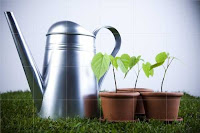Late winter—when deciduous plants are dormant—is the ideal time to prune summer and fall-blooming shrubs. Pruning is best at this time because the bare branches allow you to achieve the desired effect and look and the plant will suffer less shock and damage to the leafless plants.
There are many misconceptions about pruning, for example: plants will die if pruned at the wrong time of year (plants may be injured, but seldom die as a result of poorly-timed pruning); and all cut surfaces must be treated with a tree paint or tree sealer (there is conflicting evidence regarding this long held belief, and if pruned correctly, this is no longer needed).
Pruning is the selective removal of parts of a plant for one or more purposes. Following are several reasons to prune:
- To control growth and/or to direct growth for a special effect
- As a result of transplant injury
- To rejuvenate or restore
- To repair damage
- To promote flowering and fruit production and size
- To promote plant health
What and how much should you prune? In most cases, you should never prune more than one-third of the top growth of a shrub (or tree). The list of what to prune includes:
- Dead, diseased and damaged branches
- Vertical shoots from branches (water sprouts)
- The unwanted shoots growing from the base of the tree or shrub (suckers)
- Branches that are crossing
- Long, awkward limbs
- Branches that are dangling
- Insect and/or borer insect infested wood
- Spent flowers (deadheading)
- To renovate multi-stemmed shrubs, it may be necessary to prune the plant to ground level.
There are several pruning techniques used to accomplish different tasks. Pinching is used to promote the development of many branches. This technique is used to promote bush growth.
Heading back is the specific shortening of branches and is usually used in combination with thinning to give the best effect.
Thinning is the removal of the entire stem at the point of origin and stimulates new growth at this point. It removes old unproductive stems, it allows light to reach the center of the plant, and it improves air circulation within the plant.
Shearing is pruning to create an even-shaped surface, on hedges, topiary, etc. If you grow rhododendron, you should be familiar with deadheading (no, it’s not about the Grateful Dead).
Removing the old blooms allows the plant to direct its energy into growth rather than seed production. Several commonly grown summer flowering shrubs, which should be pruned in late winter before spring begins, include:
- Glossy abelia (Abelia x grandiflora) flowers are formed on wood from the previous season. To prune, pinch the most vigorous new growth in spring and remove one-third of the oldest growth.
- Butterfly bush (Buddleia davidii) flowers on the new growth. Prune back to the ground.
- Sweet shrub or Carolina Allspice (Calycanthus floridus) is a multi-stemmed shrub. Trim and thin to shape. During the growing season, pinch it back to keep this shrub small.
- Japanese privet (Ligustrum japonicum) should have the old wood removed at the ground level from time to time. Major pruning should be done in late winter; however, to maintain shape, pruning can be done anytime.
- In contrast, spring blooming shrubs such as lilac, sweet mock orange, hydrangea, forsythia, spirea should be pruned after flowering has finished in late spring.
- Lastly, before pruning your landscape shrub, know the correct identification and determine when it will bloom. If you are not sure of the name and flowering time, allow it to grow and make note when it blooms during the growing season, then prune it next year at the proper time.

